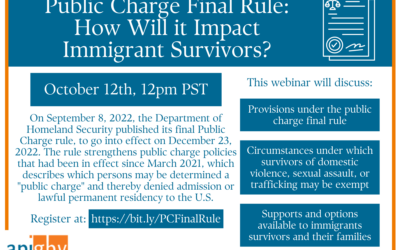This resource provides guidance on how to navigate seven different scenarios in which children and their families may benefit from support services but face intersecting immigration and child welfare legal challenges. The analysis informs not only child welfare professionals including case workers, attorneys, and judges, but also immigration law professionals whose clients may interact with the state child welfare system. Understanding the complexities that arise when families interact with both systems is a critical step in better advocacy for and support of immigrant children and families.
Seven distinct scenarios are explored:
- Case 1: A child who lacks immigration status is experiencing abuse in the home by a nonparent.
- Case 2: A mother who lacks immigration status is detained by immigration enforcement authorities and fears separation from her son, who was born in Guatemala, and her U.S. citizen daughter.
- Case 3: A child who arrived in the United States as an unaccompanied minor becomes homeless after his sponsor placement with relatives falls through.
- Case 4: A child who lacks immigration status suffers from neglect at home while residing with his father, who also lacks status.
- Case 5: The mother of a U.S. citizen child is held in immigration detention and faces possible deportation from the United States.
- Case 6: A father in a foreign country seeks reunification with his child after the baby is removed from his mother in the United States.
- Case 7: A mother with deferred action experiences domestic violence in her home but is scared to contact authorities.
Related Resources
Safeguard Asylum for Survivors – Tell Your Senator to Reject the Emergency National Security Supplemental Appropriations
February 5, 2024 On Sunday night, Senate negotiators released the text of the “Emergency National Security Supplemental Appropriations Act, 2024,” legislation intended to address defense funding and border security concerns. Unfortunately, this funding bill includes...
UPDATED Advisory: Are Victim Services Programs Liable for Criminal “Harboring” When they Work with Immigrant Survivors of Crime? 2022
This Advisory answers common questions about providing shelter and other program services to undocumented victims, describes the law and federal policy, and proposes best practices for programs
How Do Recent ‘Public Charge’ Policy Changes Impact Immigrant Survivors of Crime?
The Department of Homeland Security (DHS) is proposing a new rule that put longstanding policy about the meaning and application of the “public charge” provisions of immigration law into regulation form. This advisory describes provisions under this new proposed rule and how it will impact immigrant survivors of violence, particularly in light of the pandemic.
Public Charge Final Rule: How Will It Impact Immigrant Survivors?
10/12/22 at 12:00 - 1:00pm PSTOn September 8, 2022, the Department of Homeland Security (DHS) published its final Public Charge rule, to go into effect on December 23, 2022. The rule strengthens public charge policies that had been in effect since March 2021, which...

By ABA Center on Children and the Law
May 2018
